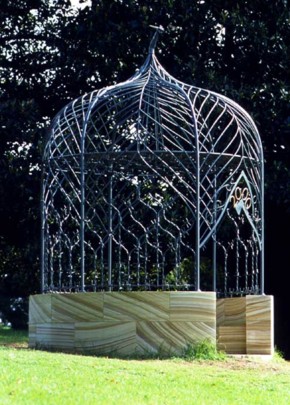The Folly
Below the House in the Botanic Gardens we came upon the structure called A Folly for Mrs Macquarie, an artwork of particularly violent aspect consisting of a bell shaped bronze cage mounted on a circular sandstone foundation; topped with a bronze arm clutching a dagger, apparently stabbing the air. Over the door is an axe. The cage is made of oversize, simulated, woven barbed wire; its bronze ceiling pierced with skeletal images that could be aboriginal. It is quite alarming. It is obviously meant to speak to a contemporary audience as barbed wire was not invented till 1874, and was first mythologised as a violent material during the First World War; 'hanging on the old barbed wire'.
Is seems to be saying something about the violence of the early colony.
Since writing my personal reactions to the piece, above, I've had a look on-line and discovered that the folly replaces one built on the instructions of Mrs Macquarie nearby; but since lost. I also found the following explanation of the symbology:
'The design elements of Fiona Hall's folly echo early aspirations for the colony, but are also mindful that there was much folly in the way in which Britain chose to colonise Australia. The doomed roof of Norfolk Island pine fronds for example refers to the colonists regard for this tree Mrs Macquarie presided over the planting of one near here in 1816 which became known as the 'Wishing Tree". However the pine's brittle timber dashed hopes that it would make excellent ship's masts. The bone ceiling refers to animals which once lived in this area and the Gothic windows represent the barbed wire used to claim and divide up the land. The finial (the dagger) is from the Macquarie family crest, while the folly floor indicates the direction of Britain from this site.'
This last claim is interesting. It contrasts a scientific fact with historical assertions, approximations and myths. You can obviously face any direction you like at the actual antipodes of London near New Zealand; due south if you like. From Sydney there is one perfect direction, that is the minimum point-to-point line, but the shortest distance relies on the method of travel; by air or following the surface; and the line found by using a string over a spherical globe differs in direction from the line on the Earth's actual oblate spheroid shape. We trust that the one chosen for the Folly is accurate, using modern astronomy and satelite measurement, but it is very unlikely that the direction looked to in 1820 would have been the same. The same problem confronts Muslims facing Mecca from Australia. But religion solves the antipodean problem easily. They simply pick a direction that 'feels right' and decree that it is the true direction for the faithful.
The image of the folly provides the icon for this article.

